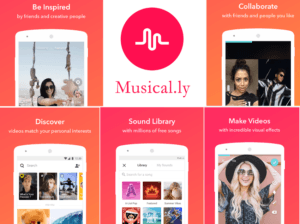Musical.ly: Breaking Through the Social Media Clutter

Just when you think the social media space is crowed enough as it is, a music video platform, Muscial.ly, breaks through the clutter and became a big hit.
Musical.ly, a DIY music-video social platform launched by two Chinese entrepreneurs – Alex Zhu and Luyu Yang, first came on the scene in 2014. It has quickly grown to a 200 million user base globally by Sep 2017 and hasn’t fallen below the top 40 lists in app store since launched.[1]
A Quick Intro into the New Social Media Hit
Musical.ly primarily targets at 13 to 18-year-old teens. Users could make short music videos clips where “Musers” would lip-sync or dance or do a comedy routine to a popular music and audio bites, then share with friends on the platform.
With the app’s virtual gift program, users could buy coins which they tip acts with (100 coins for $0.99). The act receives 50% of every dollar in payment, while 30% goes to Apple and Google’s standard platform fees and 20% to Musical.ly.[2]
Lesson One – how to take on Incumbents in a crowded market
The social media market in US, dominated by Facebook, Snapchat and Instagram, seems like such a crowed market that will deter any new comers from entering. In my opinion, Muscial.ly was able to successfully carve out a space for itself by doing below things right:
- Winning the mobile-first teens demographic: As technology becomes commonplace, the age to adopt tablets, mobile and other devices become younger and younger. The apps that can capture the attention of mobile-first teens will become increasingly influential. As Facebook and Snapchat are perceived as used by moms, brothers and sisters, a platform that is primarily consisted of teenagers would be a pop.
- Selecting the right format and capitalizing on desire to be creators: As information becomes more fragmented, people like to consume content in easier and shorter format. A 15 second video would exactly solve this customer pain point. However, video itself is not something new. You have to think of ways that would make a video interesting. For musical.ly, the new value-adds are the features of lip-syncing to pop songs, ability to adjust speed and add effects to personalize your own music videos.
Hence, for a startup to take on incumbents, one has to come up with the right recipe –going after a unique customer segment, differentiating in product offering and identifying the most urgent pain point.
Lesson Two – how to scale quickly
- Continuously testing and refining: Ten months after launch, Muscal.ly’s user growth became stagnant. In order to unlock more growth potential, the team focused on improving design, making small tweaks such as adding Musical.ly on shared video to enable more social sharing. Two months later, on July 6, it hit the No. 1 app in the iTunes app store.[1]
- Leveraging existing mature platforms: Musical.ly is designed to be well connected with other apps such as Instagram and YouTube. Experienced “Musers”, who are self-made digital natives, can cross-promote their other socials easily onto different platforms.
Hence, for a startup to scale quickly, one has to constantly pulse check on user growth and improve product features. When company is still growing, think about ways to leverage existing platforms to drive traffic.
Lesson Three – will the disruptor now be disrupted?
In Nov 2017, Musical.ly was acquired by Bytedance Technology Co., the parent company for TouTiao News, for $1 billion. The Parent company then launched its own version of music social app, Tik Tok, into Asia.
Viv Gong, Head of Marketing, Tik Tok, said: “The Tik Tok community is growing rapidly in China and now it’s starting to spread quickly into more global markets. Talented youth across the region have a reason to celebrate, create, and share as making music videos is becoming easier and more fun with advanced technology and a world of Tik Tok supporters to cheer them on.”[6]
As we look forward, what should be the next step for musical.ly – aging up from teens to adults, or providing more value-added features to existing young consumers? If consumer demands and preferences shift so quickly, how should musical.ly defend itself from yet another social app targeting at an even young generation with even more interesting features? Will the disruptor finally be disrupted?
Sources:
[1] The inside story of Musical.ly – Business Insider, http://www.businessinsider.com/what-is-musically-2016-5
[2] From Musers To Money: Inside Video App Musical.ly’s Coming Of Age, https://www.forbes.com/sites/natalierobehmed/2017/05/11/from-musers-to-money-inside-video-app-musical-lys-coming-of-age/#4d284b5a6cff
[3] 22 Musical.ly Statistics and Facts (December 2017) | By the Numbers, https://expandedramblings.com/index.php/musically-statistics/
[4] Musical.ly has lots of users, not much ad traction, https://digiday.com/marketing/musical-ly-starts-selling-ads/
[5] Musical.ly Has become An Essential Proving Ground For Digital Natives, http://www.hypebot.com/hypebot/2017/11/musically-a-proving-ground-for-digital-natives.html
[6] Toutiao parent launches global competitor to musical.ly, https://technode.com/2017/09/14/toutiao-backed-douyin-launches-competitor-to-musical-ly-tik-tok/




This reminds me of my little cousin who is absolutely in love with this app! What I am curious about is its source of revenue stream. It seems that it’s “gift program” is not a very stable source of revenue for the Company. Are the users required to purchase these coins? Or are there incentives that encourage people to buy these virtual gifts for others? I think it’s important for Musical.ly to bring in other partners onto this platform as a way to not only diversify its business, but also strengthen its network effect by creating more value for a different segment of the market. For example, I can see Musical.ly partnering with movie studios or gaming companies to develop capabilities that would allow its users to participate and reenact memorable scenes from movies/games and use “virtual props”, different voice effects, and theme songs. These exclusive partnerships will help differentiate the app from other competitors and will also boost its advertising revenue so that it is not solely dependent on its users.